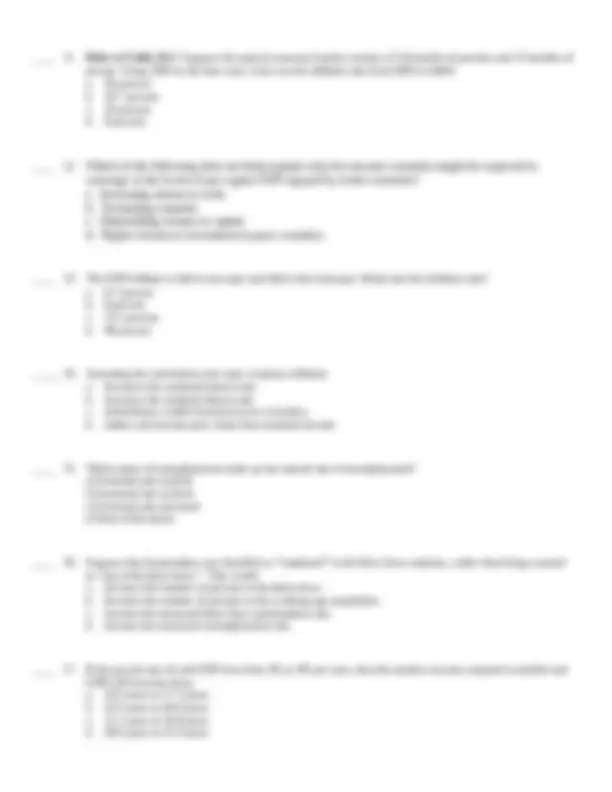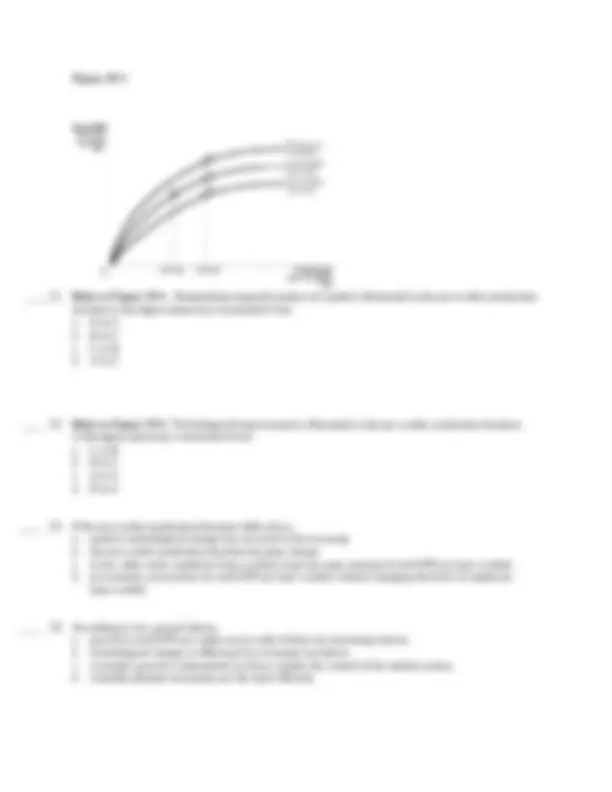





Study with the several resources on Docsity

Earn points by helping other students or get them with a premium plan


Prepare for your exams
Study with the several resources on Docsity

Earn points to download
Earn points by helping other students or get them with a premium plan
Community
Ask the community for help and clear up your study doubts
Discover the best universities in your country according to Docsity users
Free resources
Download our free guides on studying techniques, anxiety management strategies, and thesis advice from Docsity tutors
macro econ practise midterm first for sem, few topics
Typology: Quizzes
1 / 7

This page cannot be seen from the preview
Don't miss anything!




____ 1. When a firm sells a good or a service, the sale contributes to U.S. GDP, as measured by the expenditure method a. only if the buyer of the good or service is a household. b. only if the buyer of the good or service is a household or another firm. c. only if the good or service was produced within the U.S. d. only if the good or service was sold within the U.S. ____ 2. GDP is defined as a. the market value of all goods and services produced within a country in a given period of time. b. the market value of all goods and services produced by the citizens of a country, regardless of where they are living in a given period of time. c. the market value of all final goods and services produced within a country in a given period of time. d. the market value of all final goods and services produced by the citizens of a country, regardless of where they are living, in a given period of time. ____ 3. If GDP is growing at 5%, and population is growing at 2%, what is the (approximate) growth rate of per capita GDP? a. 3% b. 5% c. 7% d. 2.5% ____ 4. A steel company sells some steel to a bicycle company for $100. The bicycle company uses the steel to produce a bicycle, which it sells for $200. Taken together, these two transactions contribute a. $100 to GDP. b. $200 to GDP. c. between $200 and $300 to GDP, depending on the profit earned by the bicycle company when it sold the bicycle. d. $300 to GDP. ____ 5. A U.S. publisher purchases new computers that were manufactured in the U.S. This purchase by itself makes a. a positive contribution both to investment and to GDP. b. a positive contribution both to consumption and to GDP. c. a positive contribution to GDP, but it does not affect investment or consumption. d. a positive contribution to investment, but it does not affect GDP.
____ 6. Transfer payments are a. included in GDP because they represent income to individuals. b. included in GDP because the income eventually will be spent on consumption. c. not included in GDP because they are not expenditures on currently produced goods or services. d. not included in GDP because taxes will have to be raised to pay for them. ____ 7. Which of the following statements about GDP is correct? a. Nominal GDP values production at current prices, whereas real GDP values production at constant prices. b. Nominal GDP values production at constant prices, whereas real GDP values production at current prices. c. Nominal GDP values production at market prices, whereas real GDP values production at the cost of the resources used in the production process. d. Nominal GDP is always higher than real GDP. ____ 8. In the country of Mainia, only cranberries and maple syrup are produced. In 2006, 50 units of cranberries are sold at $20 per unit, and 100 units of maple syrup are sold at $10 per unit. The price of cranberries was $ per unit and the price of maple syrup was $15 per unit in 2005, which is the base year. For 2006, a. nominal GDP is $2,000, real GDP is $2,000, and the GDP deflator is 100. b. nominal GDP is $2,000, real GDP is $2,500, and the GDP deflator is 125. c. nominal GDP is $2,500, real GDP is $2,000, and the GDP deflator is 83.3. d. None of the above is correct. ____ 9. What basket of goods is used to construct the CPI? a. a random sample of all goods and services produced in the economy b. the goods and services that are typically bought by consumers as determined by government surveys c. only food, clothing, transportation, entertainment, and education d. the least expensive and the most expensive goods and services in each major category of consumer expenditures Table 24- Year Peaches Pecans 2005 $11 per bushel $6 per bushel 2006 $9 per bushel $10 per bushel ____ 10. Refer to Table 24-1. Suppose the typical consumer basket consists of 10 bushels of peaches and 15 bushels of pecans. Using 2005 as the base year, the CPI for 2006 is a. 100. b. 120. c. 200. d. 240.
____ 18. When an economy faces diminishing marginal product of capital, a. the slope of the per-worker production function becomes steeper as capital per hour worked increases. b. the slope of the per-worker production function becomes flatter as capital per hour worked increases. c. the per-worker production function shifts to the right. d. the per-worker production function shifts to the left. ____ 19. The country of Aquolina imports $20B worth of goods from other countries. It exports $15B worth of goods. Its GDP is $250B. Its government purchases $30B worth of goods and services each year, and distributes $20B in transfer payments. Aquolina’s consumers buy $150B worth of goods and services each year. What is investment in Aquolina? a. $35B b. $55B c. $75B d. Cannot be determined with the information given ____ 20. Suppose that in the small country of Sociopolis there are 6 million people in the working age population, that the labor-force participation rate is 70 percent, and that there are 3.8 million people employed. To the nearest tenth, what is the unemployment rate? a. 10.5% b. 9.5% c. 6.7% d. None of the above
Figure 10- ____ 21. Refer to Figure 10-1. Diminishing marginal product of capital is illustrated in the per-worker production function in the figure above by a movement from a. D to C b. B to C c. C to D d. A to C ____ 22. Refer to Figure 10-1. Technological improvement is illustrated in the per-worker production function in the figure above by a movement from a. C to B b. B to C c. A to C d. D to C ____ 23. If the per-worker production function shifts down, a. positive technological change has occurred in the economy b. the per-worker production function becomes steeper c. it now takes more capital per hour worked to get the same amount of real GDP per hour worked d. an economy can increase its real GDP per hour worked without changing the level of capital per hour worked ____ 24. According to new growth theory, a. growth in real GDP per capita occurs only if there are increasing returns. b. technological change is influenced by economic incentives. c. economic growth is determined by forces outside the control of the market system. d. centrally-planned economies are the most efficient.
EC 102 Practice Midterm 1 Answer Key